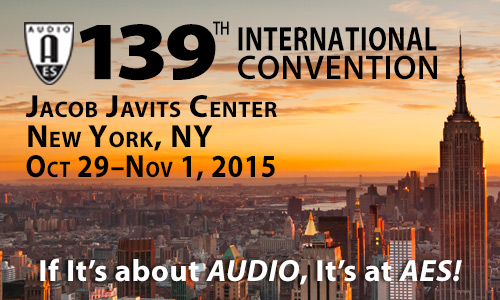
AES New York 2015
Paper Session P10
Friday, October 30, 2:00 pm — 4:30 pm (Room 1A07)
Paper Session: P10 - Recording & Production
Chair:
Grzegorz Sikora, Harman - Pullach, Germany
P10-1 Lossless Audio Checker: A Software for the Detection of Upscaling, Upsampling, and Transcoding in Lossless Musical Tracks—Julien Lacroix, Independent Developer - Aix-en-Provence, France; Yann Prime, Independent Developer - Aix-en-Provence, France; Alexandre Remy, Independent Developer - Aix-en-Provence, France; Olivier Derrien, University of Toulon / CNRS-LMA - Toulon, France
Internet music dealers currently sell “CD quality” tracks, or even better (“Studio Master”), thanks to lossless audio coding formats (FLAC, ALAC). However, a lossless format does not guarantee that the audio content is what it seems to be. The audio signal may have been upscaled (increasing the resolution), upsampled (increasing the sample rate), or even transcoded from a lossy to a lossless format. In this paper we describe a new software that analyzes lossless audio tracks and detects upsampling, upscaling, and transcoding (only for AAC in this early version). Validation tests over a large music database (with groundtruth available) show that this method is fast and accurate: 100% of success for upscaling and transcoding, 91.3% for upsampling.
Convention Paper 9416 (Purchase now)
P10-2 Comparison of Audio Signals Obtained with Source Overlay (OAS) and Other Conventional Recording Methods—Juliette Olivella, Universidad de San Buenaventura - Bogotá, Colombia; K2 INGENIERIA; William Romo, Universidad de San Buenaventura - Bogotá, Colombia; Dario Páez, Universidad de San Buenaventura - Bogotá, Colombia
Overlay Model of Acoustic Sources (OAS) is an unconventional recording method with a stereo microphone array. This model was proposed as a methodological alternative that allows emulating a recording single-take of a musical group. It is based on the presumption of a linear behavior in a recording system and involves doing partial captures of musical instruments that integrate the entire assembly. Experimental tests were done to corroborate the system's linearity; two speakers are used instead of musicians and audio is recorded with conventional techniques and model of Overlay of Acoustic Sources. The audios were discretized using MATLAB in order to evaluate their physical parameters and the correlation coefficients between energy, maximum values, minimum values, frequency response, the zero crossings rate, and spatiality of recordings. All the research sought to answer the question if it is possible to get an audio signal able to imitate the signal characteristics captured in real time in a recording by takes. The results showed that it is possible when the recording is performed with the method of overlay of acoustic sources (OAS).
Convention Paper 9417 (Purchase now)
P10-3 Process Improvement in Audio Production from a Sociotechnical Systems Perspective—Gerhard Roux, Stellenbosch University - Stellenbosch, Western Cape, South Africa
Audio professionals involved in live sound reinforcement, record production, and broadcasting are continuously solving complex problems in creative ways. It is wasteful if the pragmatic methodologies used in solving these problems do not contribute towards a reusable model of process improvement. This paper suggests a systems-level engagement with audio production that strikes a balance between human creativity and technological infrastructure. A conceptual model of process improvement is developed through analysis of audio production as a complex system and subsequently implemented through an action research methodology in multiple case studies. The study found that significant quality improvements in audio production could be attained through a sociotechnical systems approach. The results imply that the application of process improvement methodologies can coexist with creative social practice, resulting in improved technical performance of production systems.
Convention Paper 9418 (Purchase now)
P10-4 Listener Preference for Height Channel Microphone Polar Patterns in Three-Dimensional Recording—Will Howie, McGill University - Montreal, QC, Canada; Centre for Interdisciplinary Research in Music Media and Technology (CIRMMT) - Montreal, Quebec, Canada; Richard King, McGill University - Montreal, Quebec, Canada; The Centre for Interdisciplinary Research in Music Media and Technology - Montreal, Quebec, Canada; Matthew Boerum, McGill University - Montreal, QC, Canada; Centre for Interdisciplinary Research in Music Media and Technology (CIRMMT); David Benson, McGill University - Montreal, Quebec, Canada; The Centre for Interdisciplinary Research in Music Media and Technology - Montreal, Quebec, Canada; Alan Joosoo Han, McGill University - Montreal, QC, Canada; Centre for Interdisciplinary Research in Music Media and Technology (CIRMMT) - Montreal, Quebec, Canada
A listening experiment was conducted to determine if a preference exists among three microphone polar patterns when recording height channels for three-dimensional music production. Seven-channel 3D recordings of four different musical instruments were made using five-channel surround microphone arrays, augmented with two Sennheiser MKH 800 Twin microphones as height channels. In a double-blind listening test, subjects were asked to rate different mixes of the same recordings based on preference. The independent variable element in these mixes was the polar pattern of the height channel microphones. Analysis of the results found that the vast majority of subjects showed no statistically significant preference for any one polar pattern.
Convention Paper 9419 (Purchase now)
P10-5 Listener Discrimination of High-Speed Digitization from Analog Tape Masters with Spectral Matching—Nick Lobel, Belmont University - Nashville, TN, USA; Eric Tarr, Belmont University - Nashville, TN, USA; Wesley Bulla, Belmont University - Nashville, TN, USA
This study investigated whether listeners could discriminate between real-time (RT) and double-speed (DS) digital transfers from analog tape recordings. Signals were recorded to tape at 15 inches per second (ips), then digitized at two copy rates: 15 ips (RT) and 30 ips (DS). The DS transfers were digitally time-stretched and spectrally processed to match the duration and frequency response of the RT transfers. Thirty-one listeners participated in an ABX experiment to discriminate between the RT and DS transfers. Results show discrimination between RT and DS transfers was not statistically significant. Additionally, discrimination did not vary significantly across different types of source signals.
Convention Paper 9420 (Purchase now)
